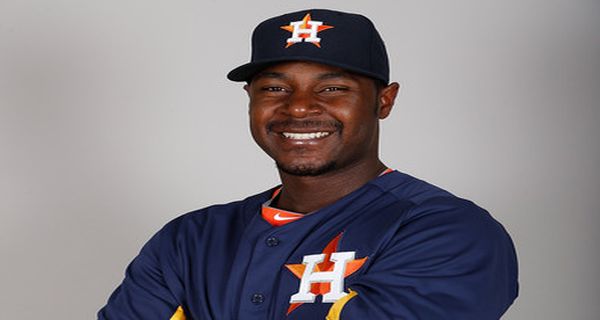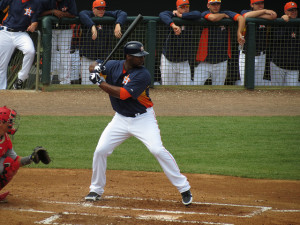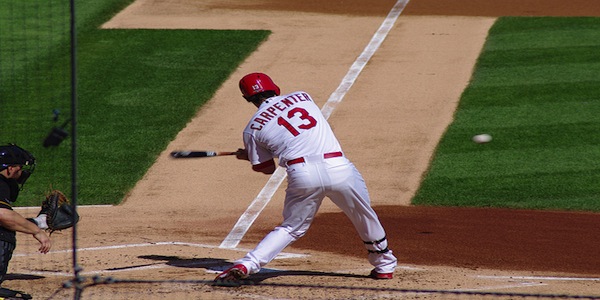2013 Fantasy Baseball, Mixed-League Sleepers: Hitters

In most fantasy baseball leagues bench spots are limited, and usually reserved mostly for pitchers since they’re more easily interchangeable due to playing once every five days instead of everyday like most position players. So sometimes a fantasy owner won’t have more than two or three hitters on his or her bench. Cody Ross, Nick Markakis and Michael Cuddyer – late-round guys with little to no upside who most owners will fill their rosters out with – are always going to be available on the waiver wire. Chances are none of those guys will break out and hit 30 homers or be a key piece to your team. When rostering backup position players you want to aim for upside and position eligibility. The upcoming five players offer those and should be players you target in the later rounds of your drafts.

Chris Carter – One of the newest Astros will start the season as only first base-eligible, but he should be starting in left field for Houston on Opening Day thus gaining outfield eligibility very soon. In my 16-team league I was targeting Carter throughout the draft and was very glad to nab him in the 20th round at 307th overall – about 28 spots after where he’s going in drafts at Mock Draft Central. I called him “the cheapest 30 homers around” after I drafted him, and whether he’s at 279 or 307 he’s going to be a bargain. Carter hit 16 home runs last year in only 260 plate appearances, hitting a homer in only 5 percent of at-bats at Oakland’s pitcher-friendly stadium. On the road his slugging went up 99 points and his home-run rate nearly doubled to 9 percent. Houston’s Minute Maid Stadium has a left field and left-center field porch that are only 315 and 362 feet, respectively, from home plate compared to O.co Coliseum’s fences being 330 and 367 feet, respectively. Carter shouldn’t need more than 140 games to hit 30 home runs this year.
Matt Carpenter – The Cardinals released Ronny Cedeno a few days ago, all but assuring Carpenter the starting second base gig this season. He could easily qualify at third, first and outfield in your league already, so getting second base eligibility would just be icing on top of the cake. Carpenter doesn’t have the upside of Carter, but his 272 MDC average draft position is way too low for what Carp should bring this season. He played very well in his first full season, acquiring a 125 OPS+ with nice extra-base hit numbers. His walk, strikeout and BABIP rates were very close to his minor-league numbers so he should be able to put up similar stats in his sophomore campaign. He won’t hit over 20 homers, but his average, runs and RBIs should be good especially considering, at his cost, he’ll be just your starting corner infielder.
Cameron Maybin – The lone player on this list who’ll qualify at only one position, Maybin’s also the only guy whom I don’t have very many stats to backup why I believe you should roster him. At an ADP of 142, he’s a lot more expensive than the previous two players, but compared to the other outfielders being drafted around him he’s got some of the most upside out of those players. Maybin will be 26 soon after the season starts, so he could just be a late bloomer. Maybin’s second-half OPS was 139 points higher than his first half OPS, as he struck out less (17.7 percent, down from 21 percent) and had more luck on balls in play (.333 BABIP, up from .261). He’s always had a high BABIP, so that’s nothing out of the ordinary for him. Let’s hope he can improve on his second-half performance, but at the very least he’ll give you plenty of steals.
Jed Lowrie – Swapped for Carter in February, Lowrie only has shortstop eligibility right now. But he’s Oakland’s projected starter at third and could easily fill in for extended periods at first and second, too. Lowrie’s always hurt, but with a 337 ADP his injury concerns are little to worry about. Last year he hit 14 home runs in the first half with more than respectable walk and strikeout rates. His home run/fly ball rate was similar to years’ past, so as long as he’s healthy he should be able to repeat last year’s power numbers despite his move to Oakland.
Kyle Seager – Seager qualifies at second and third, and the 25-year-old quietly put up a solid sophomore season. He raised his walk rate and lowered his strikeout rate, and his final stat line of .259/.316/.423 doesn’t tell the whole story. Well, yes it does: Seager’s a good hitter on the road, but SafeCo Field’s dimensions hurt him just like they hurt every hitter. Seager hit .293/.324/.511 with 15 of his 20 homers on the road. He was also one of only three third basemen to hit 20 or more homers while stealing double-digit bases. Seager also hit much better on the road in his rookie season, so he should continue to put up solid numbers overall with the chance of even better numbers due to SafeCo’s fences coming in.





